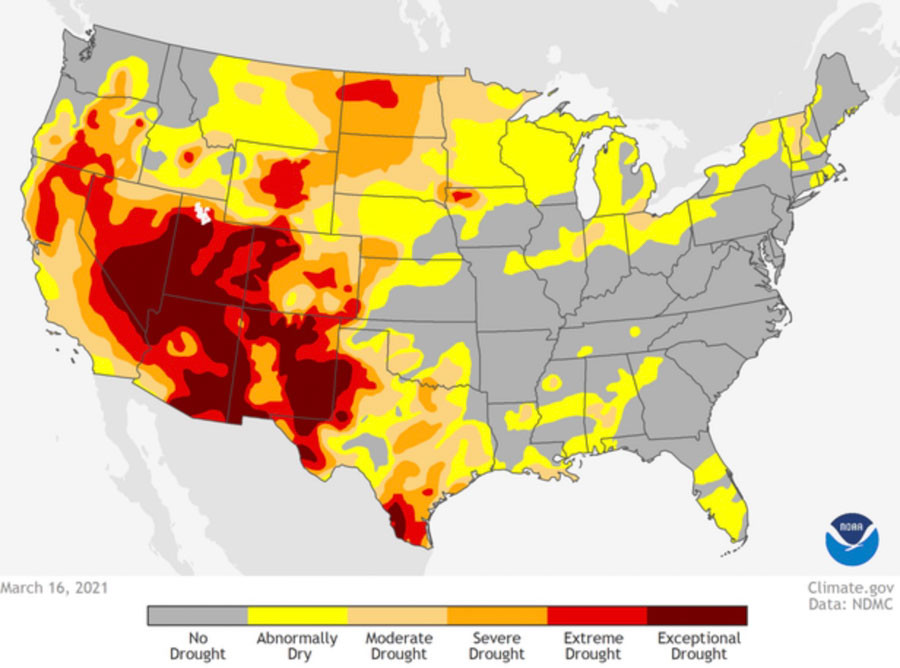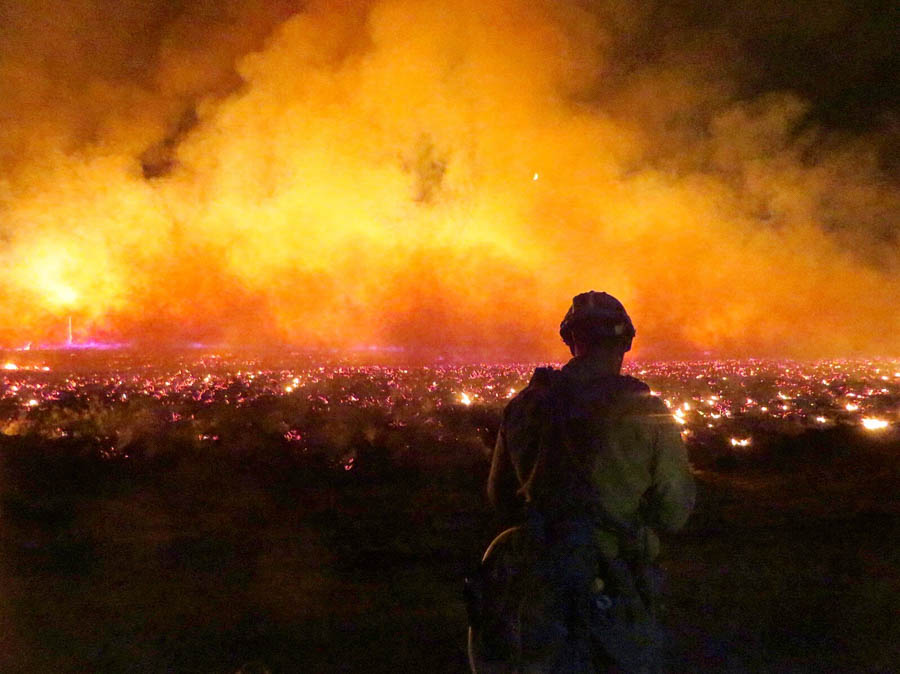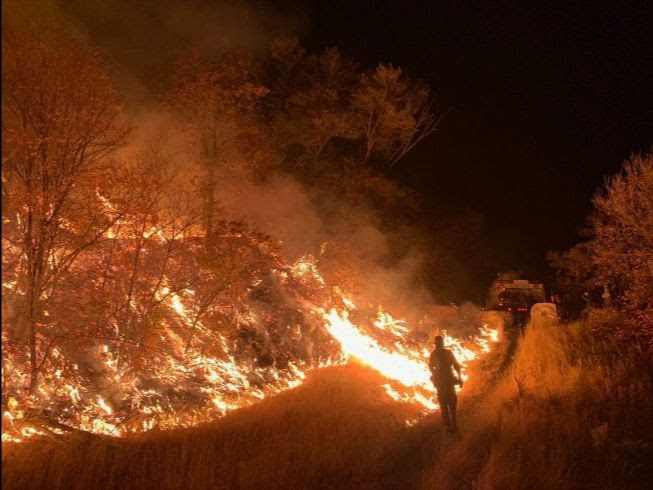
This article was first published at Writers on the Range
By Harrison Raine
For the 2021 fire season, the writing is on the wall. The West, despite a few days of intense winter, is far drier than it was leading up to last year’s record-breaking fires.
As a hotshot crew member, the reality of what’s to come fills me with two distinct thoughts: money and dread. With my financial stability tied to overtime pay, I know that my pockets will be full when I am laid off next winter. But the unrelenting fires that stand between now and then make me nervous.
I also know that I am not alone. Across the West, people in homes and communities are filled with anxiety as they look at dry timber and brown hillsides that are usually white this time of year. For them, when the air fills with smoke, there won’t be any fire paychecks, just a prolonged sense of uncertainty.
Drought levels often serve as a good indicator of the fires to come, and things are far worse now than they were in the build-up to 2020. Rich Tinker, an author of the U.S. Drought Monitor at the Climate Prediction Center, told me, “In 2020, the highest we got to anywhere, was a D2 — Severe Drought. Now we are looking at D3 — D4 — Extreme and Exceptional Drought across much of the West and almost all of the Southwest.”

When Nick Nauslar, a fire meteorologist at the National Interagency Fire Center, talks about the fire season to come, he’s particularly blunt: “The deck is stacked against us. I fully expect a busier season than normal across the Southwest.”
For Tinker and Nauslar, the areas of concern primarily encompass the Four Corners states of Utah, Colorado, New Mexico and Arizona. When you put together light snowpack, dry fuels and high temperatures, every wildland firefighter knows what that means.
In my time as wildland firefighter, the question I get asked again and again is whether I am ever scared. The answer to this question is “yes,” but not in the life or death way in which its asked.
There are far more constant threats than the flames themselves. Smoke, for one. Carbon emissions, for another.
I think I’m worried most by the knowledge that damage from these wildfires affects the health of millions of people, and that the large wildfires of today are ensuring bigger ones in the future. Everyone should be concerned about this reality, not just those of us on the fire line.
Wildfires and their management are known by some researchers as a “wicked problem,” where no optimal solution exists. For decades, forest managers were convinced that suppressing all fires was the answer. But we’ve known for a while now how misplaced those beliefs were, even as many agencies cling to that failed strategy of a century ago.
Jerry Williams, former fire and aviation director for the U.S. Forest Service, puts it best about our stubborn wrongheadedness: “Every year we set a new record, we invest more in (fire) suppression, invest less in mitigation and wonder why we’re not getting on top of it.” If someone who directed the largest wildland firefighting force in the world makes this statement, it’s probably time to try something else.

What we need are policies and programs that address wildfires in ways beyond putting fires out. This Spring, Colorado showed that it’s willing to learn from last season’s pain when Gov. Jared Polis and State legislators from both sides of the aisle released a series of bills aimed at wildfire mitigation, not only wildfire suppression.
These bills are exciting for several reasons such as: allocation of millions for forest health projects and grants for communities and individual homeowners to carry out their own hazard reduction projects. Also there is an effort to seek out incentives for markets to address fuel mitigation through biomass energy.
The millions the state spends now on restoring forests and hardening homes pale in comparison to the costs of firefighting and rebuilding homes. Every dollar spent on prevention saves $17 in suppression, according to a report from former Utah Gov. Gary R Herbert.
There is also a bill to allow former inmates with firefighting experience to seek future employment with the state, which will help ensure a consistent workforce.
I hope the federal government is taking notes.

Harrison Raine is a contributor to Writers on the Range, a nonprofit dedicated to spurring lively conversation about the West. He started fighting wildfires in 2016 and is a recent graduate of Colorado College.

I now this will not be well received and I am okay with that, it’s just my opinion. First there is nothing we can do now or in the future to fix this and certainly we can point in many directions as to why, it would require resources and funding that will never be enough, we know what needs to be done and in some cases on a very small scale we have been successful, however these small successes required much effort and a lot of money to accomplish.
I used to support the idea of RX burns, no longer, the reason I no longer support RX is that we do not do enough of it to make a real difference, from a management perspective RX planning and implementation is extremely difficult, ie. 2-3 yrs of planning and prep before you implement. Not to mention the liability.
In So Cal where there is a very high fire return interval/occurrence do we really need to put fire on the ground, I think not.
I believe in having a well thought out pre attack plan and defensible space, but even community protection is very difficult to achieve, it takes money and resources.
I know one thing to be certain, the natural resource agencies will continue to make a difference, because they have to try, we all have to try.
But I believe this planet of ours is tired and in spite of our best efforts the outcome will not be a good one.
One last thought, for those that reside in the interface and interior they do so at their own risk or it should be at their own risk, they are responsible for insuring defensible space, we very often send in resources and put them in harms way. Why? Because there is an unrealistic expectation that we will save there dreams…..
A rant of an old retired FF……Peace…….
We cannot reasonably expect this or any other problem of magnitude to be solved by government in any form. Fed state and local have proved that for all but 100 years now in terms of wildfire. The sooner everyone (especially those in DC) get on board with running things as a business with profit, loss, accountability at all levels and stop printing money to be wasted throwing at these problems, the sooner these problems will be fixed. The fact that so many in fire have to depend on overtime to make a living is another good indicator Uncle Sam has no business sense.
A business approach to the problem will not work. That’s because with a business approach it is all about balancing costs and benefits which is fine when everything has a definite costs and benefit associated with it. Wildland fire and the ecosystems it occurs in have have much, if not most, of the costs and benefits associated with intangibles — meaning you can’t effectively put a price on them. And even if you could put a price on some of them (e.g. timber), you’d have to have an extensive and complex database to evaluate each different watershed when it came to making fire management choices — do I conduct a burnout in this stand which has X timber value or hope the fire misses it and burn this other stand that has a higher or lower value?
One of the great fallacies today is that a business approach is the best solution to all problems. It’s attractive because in many ways it simplifies choices. But it does so by ignoring externalities and intangibles. And with wildland fire and managing ecosystems and the WUI, it would be a disaster.
As much as I believe in fast, aggressive IA, it just compounds the problem, as we all know. On the other hand, I don’t believe in making 100 acre fires into 100,000 acre fires (or more). Examples like the Bush and Bighorn fires in AZ are sad. It will take a combination of all aspects of fuels and fire management together to swing the pendulum back, with national support and local implementation. In the meantime, fight fire aggressively, but provide for safety first.
“What we need are policies and programs …”.
I have been around long enough to have lost count of all the good intentioned and expensive policies and programs implemented by fire “leadership”.
There was a policy back in the day, it was referred to as the “10 am policy” in which all new fire starts were to be suppressed at 10 acres and or by 10am the following morning. This required a commitment to aggressive initial attack. In conjunction and during this period of time the agency was also actively involved with managing forests through logging, brush disposal, silviculture and grazing.
No, we are not going back to this. The public and the “expects” had decided that these were “misplaced” practices. In addition, the multitudes of people who now build and live in the wildlands are not going to assume personal responsibility for the risk they take.
Instead, todays “experts” now have the answers and politicians will be hailed as progressive and caring in spending millions of tax payer dollars. All the while the dirty little secret of allowing wildfires to grow to megafire size, in an attempt to restore ecosystems, will continue.
The 10 AM policy and over-grazing is exactly how we got here, but don’t let things like facts and logic get in the way of your opinion. I am sure you know more than “experts”.
As joe pointed out below, the “10AM policy” is part of the problem.
The key problem is that with the 10am aggressive suppresion policy we got really good at suppressing the small, light fires in ecosystems like the ponderosa pine communities where letting them burn would’ve been much more ecologically appropriate. This led to fuel build-ups and denser stands because the fire didn’t kill of the white fir or Douglas-fir seedlings that would otherwise move in (and did). We weren’t however any better at putting out really large fires because when the conditions are right for large conflagrations almost nothing is going to stop them once ignited except for the weather.
So now we’ve got large fuel loads over extensive areas combined with a warmer (and hence drier) western climate which increases insect and disease impacts on top of the drought stress and creating the conditions we experience now.
The only long-term effective solution is to work on fuel management, thinning and restoration work in overly dense stands, and make a concerted effort to reduce climate change impacts. And of course, greatly reduce the expansion of the WUI.
Colorado legislature will appropriate $30.6B for the FY2021 budget. The governor requested $78M for fire management. A step in the right direction but it represents only 0.25% of appropriated funds for a problem that impacts the half of the state’s population that lives in the WUI, most of the tourism industry, and most of the watersheds.
Maybe next year we can get all the way up to 0.5%.
I consider the overall dryness as “The earth is sick”. Each year I hope it will get better. So far it hasn’t. Last year in Phoenix we didn’t have the usual Monson rain (the first time in 9 years). So, it went for 8 months without rain and when it finally rained I stood by my sliding door looking at backyard to see how much rain we would get. It only rained enough to wet the ground. A few days ago I read a news that Taiwan (in Asia) hasn’t had rain for 10 months for the first time in half a century. A national ritual was held to pray for rain. It is pretty serious and scary.
Before I comment, can I really believe that “lively conversation” means a truly vigorous examination of facts, or yet another teeter-totter of opinions?